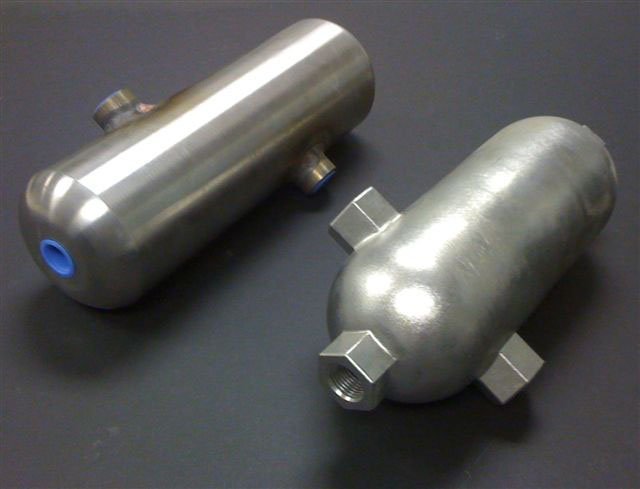What is a Condensate Pot?
A condensate pot is essential in industrial systems for trapping condensate, ensuring accurate pressure readings, protecting instruments, and enhancing system efficiency.

A condensate pot, also known as a seal pot or condensate chamber, is a crucial component in industrial systems where steam, gas, or liquid is used for pressure measurement or flow control. These pots are specifically designed to trap and collect condensate (the liquid that forms when steam or gas cools) and prevent it from reaching sensitive instruments, ensuring accurate readings and system efficiency. In this blog, we’ll explore what a condensate pot is, how it works, its key applications, and why selecting a high-quality condensate pot is essential for industrial operations.
1. How Does a Condensate Pot Work?
The primary function of a condensate pot is to separate condensate from the main fluid in a pipeline system. When high-temperature steam or gas passes through a system, it can cool down and form liquid droplets. If these droplets are allowed to enter pressure transmitters, flow meters, or other instrumentation, they can cause inaccurate readings or even damage sensitive equipment.
A condensate pot works by:
- Collecting Condensate
It traps the condensate before it reaches the instrumentation. This ensures only the desired fluid (in vapor or gas form) is transmitted further. - Maintaining Pressure Balance
By holding the condensate at a fixed level, the pot helps maintain a stable pressure balance, which is critical for accurate measurements. - Preventing Instrument Damage
Without a condensate pot, instruments exposed to high-temperature steam or gas could corrode or malfunction due to contact with condensate.
2. Key Features of a Condensate Pot
A high-quality condensate pot offers several essential features:
- Corrosion Resistance
Since condensate pots are used in high-temperature and high-pressure environments, they are typically made from corrosion-resistant materials like stainless steel, carbon steel, or alloy steel. - Durability
The design ensures the pot can withstand extreme conditions without compromising performance. - Standardized Connections
Condensate pots come with threaded or flanged connections that meet industry standards, making them compatible with various systems. - Customizable Designs
Depending on the application, condensate pots can be customized in terms of size, material, and connection type.
3. Applications of Condensate Pots
Condensate pots are widely used in industries where accurate pressure or flow measurements are critical. Some of the key applications include:
Oil and Gas Industry
In oil and gas pipelines, pressure monitoring is vital for safe operations. Condensate pots ensure accurate readings by preventing gas or liquid condensate from reaching pressure transmitters.
Petrochemical Industry
Petrochemical plants often operate under high temperatures, where steam and gas are integral to the process. Condensate pots help maintain the integrity of the measuring instruments by separating condensate effectively.
Power Generation
In power plants, especially those using steam turbines, accurate pressure measurement is essential for efficient operation. Condensate pots play a crucial role in ensuring proper steam flow monitoring.
Pharmaceutical Industry
In pharmaceutical manufacturing, where steam is used for sterilization and process control, condensate pots help maintain precise pressure control, ensuring consistent product quality.
4. Benefits of Using a Condensate Pot
Using a condensate pot offers numerous advantages:
- Enhanced Measurement Accuracy
By preventing condensate from entering instrumentation, the pot ensures accurate pressure and flow readings. - Prolonged Instrument Life
Sensitive instruments are protected from corrosion and damage caused by liquid condensate, reducing maintenance costs and downtime. - Improved System Efficiency
Stable pressure readings lead to better process control, improving the overall efficiency of the system. - Versatility
Condensate pots can be used with various fluids, including steam, gas, and liquid, making them suitable for multiple industrial applications.
5. Selecting the Right Condensate Pot
When choosing a condensate pot, several factors need to be considered to ensure optimal performance:
- Material Selection
The material should be compatible with the fluid being handled and the operating conditions. Stainless steel is a popular choice for its corrosion resistance and durability. - Capacity
The size of the pot should be appropriate for the amount of condensate expected in the system. - Connection Type
Ensure that the connection type (threaded or flanged) matches the pipeline system specifications. - Certifications
Look for condensate pots that meet industry certifications and standards for quality and safety. - Supplier Reputation
Working with a reliable supplier ensures you get high-quality products that meet your specific requirements.
6. Why Choose a Trusted Condensate Pot Supplier?
A reliable supplier can provide condensate pots that are durable, efficient, and tailored to your needs. They should offer a wide range of options in terms of material, size, and connection type. Additionally, a reputable supplier will ensure that the condensate pots meet industry standards and provide after-sales support.
Conclusion
Condensate pots are essential components in industrial systems where steam, gas, or liquid is used. They enhance measurement accuracy, protect sensitive instruments, and improve overall system efficiency. From oil and gas to power generation, condensate pots play a vital role in various applications. When selecting a condensate pot, it’s crucial to consider factors like material, capacity, and supplier reputation to ensure long-term performance and reliability.
If you are looking for high-quality condensate pots, make sure to work with a trusted supplier who can provide products that meet your industry’s requirements. With the right condensate pot, you can maintain accurate measurements, reduce maintenance costs, and improve system efficiency.
What's Your Reaction?













